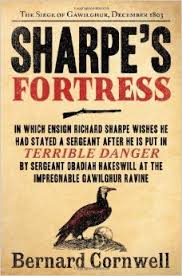 Bernard Cornwell, Sharpe’s Fortress: Richard Sharpe and the Siege of Gawilghur, December 1803 (New York: HarperCollins, 2000). Hardcover | Paperback | Kindle
Bernard Cornwell, Sharpe’s Fortress: Richard Sharpe and the Siege of Gawilghur, December 1803 (New York: HarperCollins, 2000). Hardcover | Paperback | Kindle
There is a line between war and murder, and Ensign Richard Sharpe keeps stepping over it in this third volume of Bernard Cornwell’s Sharpe series. On the one hand, we see him devising and leading the 33rd Light Infantry and a ragged assortment of Scots, Sepoys, and cavalrymen up a ladder in the escalade of the Gawilghur fortress. (Sharpe is fictional; the escalade was not.) On the other hand, we see him revenge-killing a sergeant and two privates who had betrayed him and stolen his stuff. (The men who wanted to kill him were themselves seeking revenge for the hanging of a relative, which Sharpe carried out under orders.)
When you combine the war violence and the revenge killings with the looting and rapine that accompanied British victories—indeed, when you remember that Cornwell is depicting the imperial invasion of a foreign land—you start wondering why any moral human being would derive pleasure from reading Cornwell’s books. At least that’s the question I began to ask myself while reading Sharpe’s Fortress.
Here’s the answer I came up with. Cornwell is a masterful storyteller. His depiction of the exploits of the British Army in India during the era of the Napoleonic Wars is gripping. It’s difficult not to be sucked into the narrative of men under fire—even if their cause is unjust, or at least very imperfectly just. I dare you to try and read about the repeated British infantry assaults on Gawilghur’s inner fortress—bloody, futile assaults—without marveling at the bravery of the soldiers. I dare you not to thrill when Sharpe realizes that an escalade—basically, climbing a ladder over a wall under fire—might put enough troops on the inside of the gate to open it up, and then puts that dangerous plan into action. Cornwell’s chapters describing these actions are some of the best war-writing I’ve ever read.
Another part of the answer relies on the value of an empathetic understanding of history. The Sharpe series is a work of historical fiction. The fictional part gives you empathy, as Cornwell portrays the motives (good and bad) and courage (or lack thereof) of people on both sides of a conflict. The history helps you understand the past. How did Sir Arthur Wellesley defeat Napoleon at Waterloo and become the Duke of Wellington? By putting Sharpe under Wellesley’s command, Bernard Cornwell helps you begin to understand the question.
A final part of the answer is that reading the Sharpe’s series helps form the moral conscience by giving the reader a depiction of both martial virtue and martial vice—that is, of courage versus cowardice—as well as of the horrific impact war has on soldiers and civilians alike. I don’t know that Bernard Cornwell wrote this series to provoke such thoughts. I think he certainly wants us to understand the bravery of the ordinary soldier. But I do know that reading this series inspires such thoughts in me. A book that is both a page-turner and a thought-provoker is a good book, in my opinion, even if it’s historical fiction about the fine line between war and murder.
—–
P.S. If you found my review helpful, please vote “Yes” on my Amazon.com review page.

